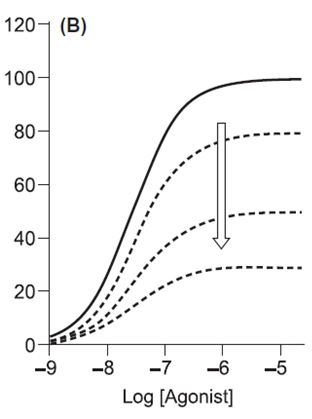Drug-Receptor interactions and organ bath experiments
1/23
There's no tags or description
Looks like no tags are added yet.
Name | Mastery | Learn | Test | Matching | Spaced |
|---|
No study sessions yet.
24 Terms
What is pharmacology?
The science studying drugs - their properties, effects, mechanisms, uses (therapeutic/adverse) on living systems.
What are the 5 natural sources of drugs?
Plants (e.g., morphine from poppy)
Animals (e.g., insulin from pigs)
Minerals (e.g., iron supplements)
Microbes (e.g., penicillin from mold)
Humans (e.g., growth hormone).
Modern synthetic drug examples?
Chemical synthesis (e.g., omeprazole)
Cell culture (e.g., urokinase)
Recombinant DNA (e.g., COVID-19 vaccines).
What are the 4 primary protein drug targets?
Receptors (e.g., beta-adrenergic receptors)
Enzymes (e.g., ACE inhibitors)
Transporters (e.g., SSRIs block SERT)
Ion channels (e.g., calcium channel blockers).
Non-protein drug target examples?
DNA (e.g., cisplatin in cancer)
Bone minerals (e.g., bisphosphonates for osteoporosis).
What is Clark’s Occupation Theory?
Drug effect depends on the fraction of receptors occupied.
Key: Response ∝ [Drug-Receptor Complexes].
Define agonist vs antagonist.
Agonist: Binds receptor → activates it (e.g., adrenaline).
Antagonist: Binds receptor → blocks activation (e.g., propranolol).
What does EC₅₀ represent?
Concentration producing 50% of max response. Lower EC₅₀ = higher potency.
Efficacy vs Potency?
Efficacy: Max possible response (e.g., full vs partial agonists).
Potency: Dose needed for effect (e.g., EC₅₀).
Why use log-scale dose-response plots?
Expands low-dose visibility → sigmoidal curve → easier EC₅₀ calculation.
Compare full, partial, and inverse agonists.
Full: Max response (e.g., morphine at µ-opioid receptors).
Partial: Submaximal response even at 100% occupancy (e.g., aripiprazole).
Inverse: Suppresses basal receptor activity (e.g., naloxone at opioid receptors).
Competitive vs Non-competitive antagonists?
Competitive: Reversible binding → shifts curve right (↑EC₅₀), same Emax (e.g., atropine).
Non-competitive: Irreversible binding → reduces Emax (e.g., phenoxybenzamine at α-receptors).
Other antagonist types?
Chemical: Inactivates drug (e.g., protamine neutralizes heparin).
Physiological: Opposing pathways (e.g., insulin vs glucagon).
Purpose of organ bath studies?
Isolate tissues to test drug effects in vitro → control concentration → measure potency/efficacy.
What does a sigmoidal log-dose curve show?
X-axis: Log[drug] → linearizes response.
Y-axis: %Max effect → identifies EC₅₀, Emax.
How to calculate drug potency?
EC₅₀ = Concentration at 50% Emax. Lower value = more potent.
Why are most drugs antagonists?
Blocking overactive pathways (e.g., beta-blockers in hypertension) is often safer than activating systems.
Example of receptor desensitization?
Chronic opioid use → downregulation of µ-receptors → tolerance.
What is chemical antagonists?
a drug combines with another to form an inactive product. For example, a positively charged protamine interacts with negatively charged heparin, forming an inactive salt aggregate.

What is physical antagonists?
Two drugs are physiological antagonists of one another, if they bind to two different receptors and produce opposite effects. (e.g. insulin and glucagon)

What is pharmacological antagonists?
alter the interaction between agonist and its receptor

Explain the process of pharmacological antagonists.
Pharmacological antagonists bind to receptors in a similar fashion to agonists
Unlike agonists, they do not elicit an independent response when bound to the receptor
They compete with agonists for the same receptor and block the agonist from binding, thereby reducing or blocking activation of receptors by the agonist

Explain competitive agonist.
qCompete with the agonist for the same receptor
qHowever, if high concentrations of agonist are administered, the agonist molecules will push the antagonist off the receptor and Maximal response (Emax) can be achieved
qIncreasing antagonist concentration displaces agonist from the receptors which means EC50 increases but Emax is unaltered (see image A on the right)


Explain non-competitive.
The effects of a non-competitive antagonist are in some ways irreversible
The antagonist binds so strongly to the receptor that even high concentrations of the agonist cannot push the antagonist off the receptor
Increasing antagonist concentration removes more receptors and it is no longer possible to occupy sufficient receptors to achieve Emax (see image B on the right)

